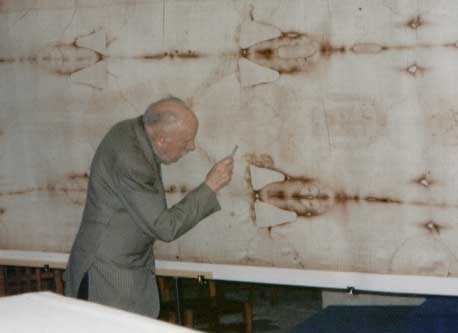Notes on ANTOINE LEGRAND
Born in Versailles, January 6th, 1904.
Died in Versailles, Saturday August 10th, 2002
He had been interested in the Shroud since 1928.
He was a painter by formation. Former student of the Superior School
of the Decorative Arts, from 1921 he was, for about ten years, the favorite
pupil and collaborator of Paul Riquet.
He exhibited his paintings in the Saloon of the French artists and
specialized himself in the restoration of pictures of the great masters.
He went on honeymoon to Turin to meet the Custodian of the Holy Shroud
and receive the Cardinal’s blessing.
He was a friend of Giuseppe Enrie’s, whom he represented in France.
|

|
He is the only qualified expert who participated in the three exhibitions
of 1933, 1973,1978.
He was also authorized, as a rare privilege, to examine the Shroud
for a long time during a night with his friend, Doctor Gallimard.
The preservation of the Shroud owes him a lot. As early as in 1933,
he had observed the deformations that the linen cloth had suffered because
of the different ways of refolding and rolling it up during the centuries.
He pointed out the remedy and was listened by the Cardinal Maurilio Fossati.
It was him who, since then, had suggested to the Cardinal Fossati a preservation
of the Linen stretched, or at least with a rolling on a great cylindrical
form.
He was the only survivor of the International Scientific Committee
gathered by Prof. Paul Vignon with whom he had worked.
He was a friend and collaborator of Doctor Pierre Barbet, whom he assisted
every Thursday in his experiences. At the end of his life, Doctor Barbet,
when he made lectures and told what he had discovered on the Shroud concerning
the tortures suffered by the Lord, was moved to the point that he cried
and asked Antoine Legrand to end in his place. He held hundreds of lectures
in the whole France.
He knew Fathers Feuillet, Dubarle, Carmignac, they themselves eminent
experts of the Shroud, with whom he worked about the translation of St.
John’s Gospel (20:3-8) regarding the position of the bandages and the Shroud
in the sepulchre.
During his studies he made important observations.
He was the first one who succeeded in putting in evidence, since 1974,
the three-dimensionality of the Shroud, asking his friend Paul Gastineau
to submit a photo of the Holy Face made by Enrie to the instrument that
Mr Gastinau had invented. So he got a true and real relief that aroused
the admiration of Eric Jumper and John Jackson, who in 1978 will get the
equivalent, but flat, thanks to the VP8 of the NASA.
He brought forth the studies related to the asphyxia, through the testimonies
of the survivors of Dachau, where experiments were effected on the convicts,
hung by their arms.
For what concerns the famous "side strip", he was convinced that during
the burial this had been cut to allow the body to be tied in the Sheet
and then sewn again, so that it would not be lost. According to recent
testimonies, he had known that the Jewish ancient formalities of burial
entirely confirmed his hypothesis.
He also dreamt that one day a micro-sampling would have been made, in
view of analyses, in the small traces that are in the center of the blood
stains of the crown of thorns in the nape of the Lord. He was convinced
that they could be the rests of "nard" of the unction of Bethany.
He was always skeptic about the presence of traces of coins and inscriptions
around the face.
Similarly, he could never be convinced about the idea that the Mandylion
and the Shroud were the same thing, as Ian Wilson thinks. His intuition
made him believe that the Shroud already belonged to the imperial treasure
quite a lot of centuries before the arrival of the image of Edessa to Byzantium
in 944.
Up to his last days, he spoke of the Shroud and asked not to feel discouraged
and, instead, look deep in the archives, convinced that they could still
hide important documents.
The Shroud had also brought him to deal with the other relics of Christ.
The bishop of Versailles turned to him for the execution of the sessions
of photos for the Tunic of Argenteuil, together with his friend Gerard
Cordonnier, and these are the only infrared photos made up to today.
In 1939 he had personally been entrusted by the Cardinal of Paris to
transport the crown of thorns from the treasure of Notre Dame up to the
cathedral of Sens, for the celebration of the 7th centennial of the arrival
of the relic in France, brought by the king St. Louis.
Nevertheless, the center of his life, up to his last breath, was the
Shroud.
Of course, he had no doubt about the error of the Carbon 14 dating.
The insurance of the carbonists on the infallibility of their method made
him smile.
For him the image of the Shroud, that cannot be reproduced, contained
in itself all the proofs of its authenticity and was the most precious
object in the world, “the eminent relic” of His Passion and Resurrection,
that the Lord had wanted to leave us.
With Antoine Legrand, the doyen of French sindonologists and an
important historical memory of the Shroud disappears.
 HOME
HOME